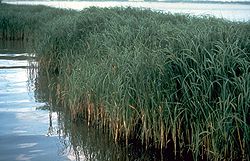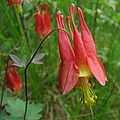
Wetland Indicator Status
Encyclopedia

Salt marsh
A salt marsh is an environment in the upper coastal intertidal zone between land and salt water or brackish water, it is dominated by dense stands of halophytic plants such as herbs, grasses, or low shrubs. These plants are terrestrial in origin and are essential to the stability of the salt marsh...
in the United States. The wetland status of 7,000 plants is determined upon information contained in a list compiled in the National Wetland Inventory undertaken by the U.S. Fish and Wildlife Service and developed in cooperation with a federal inter-agency review panel (Reed, 1988). The National List was compiled in 1988 with subsequent revisions in 1996 and 1998.
The wetland indicator status of a species is based upon the individual species occurrence in wetlands in 13 separate regions within the United States. In some instances the specified regions contain all or part of different floristic provinces and the tension zone
Tension zone
A tension zone is a transitional zone between two distinctive zones, the zones may be influenced by climatic factors, and geologicalvariation. creating a floristic tension zone.A marine tension zone may be affected by variables such as depth, climate or salinity.In a tension zone there is the...
s which occur between them.
While many Obligate Wetland (OBL) species do occur in permanently or semi-permanently flooded wetlands, there are also a number of obligates that occur in and temporary or seasonally flooded wetlands. A few species are restricted entirely to these transient-type wetland environments.
Plant species are general indicators of various degrees of environmental factors; they are however not precise. The presence of a plant species at a specific site depends on a variety of climatic
Climate
Climate encompasses the statistics of temperature, humidity, atmospheric pressure, wind, rainfall, atmospheric particle count and other meteorological elemental measurements in a given region over long periods...
, edaphic
Edaphic
Edaphic is a nature related to soil. Edaphic qualities may characterize the soil itself, including drainage, texture, or chemical properties such as pH. Edaphic may also characterize organisms, such as plant communities, where it specifies their relationships with soil...
and biotic
Biotic component
Biotic components are the living things that shape an ecosystem. A biotic factor is any living component that affects another organism, including animals that consume the organism in question, and the living food that the organism consumes. Each biotic factor needs energy to do work and food for...
factors, and the effect of individual factors such as degree of substrate saturation and depth and duration of standing water is impossible to isolate.

Indicator categories:
- Obligate wetland (OBL). Almost always occurs in wetlands (estimated probability > 99%) under natural conditions
- Facultative wetland (FACW). Usually occurs in wetlands (estimated probability 67% – 99%), but occasionally found in non-wetlands.
- Facultative (FAC). Equally likely to occur in wetlands (estimated probability 34% – 66%) or non-wetlands.
- Facultative upland (FACU). Usually occur in non-wetlands (estimated probability 67% – 99%), but occasionally found in wetlands (estimated probability 1% – 33%).
- Obligate upland (UPL). Occur almost always (estimated probability > 99% in non-wetlands under natural conditions.
A positive (+) or negative (−) sign is used for the facultative categories. The (+) sign indicates a frequency towards the wetter end of the category (more frequently found in wetlands) and the (−) sign indicates a frequency towards the drier end of the category (less frequently found in wetlands).
External Links
- 1988 National List of Vascular Plant Species that Occur in Wetlandshttp://www.usace.army.mil/CECW/Documents/cecwo/reg/plants/list88.pdf also at http://www.fws.gov/pacific/ecoservices/habcon/pdf/National%20List%20of%20Plant%20Species%201988.pdf
- 1993 Northwest region 9 Supplement to the 1988 National Listhttp://www.nww.usace.army.mil/html/offices/op/rf/wetdelww/plantlistsupp.pdf
- 1996 National List of Vascular Plant Species that Occur in Wetlandshttp://www.usace.army.mil/CECW/Documents/cecwo/reg/plants/list96.pdf

